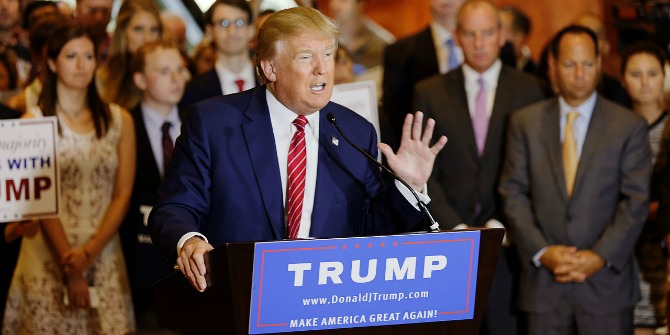 Yesterday voters in 12 US states went to the polls in what’s known as Super Tuesday – the most important date in the 2016 presidential primary thus far. Billionaire Donald Trump came out on top on the Republican side, winning seven states, and former Secretary of State Hillary Clinton beat out her sole remaining opponent, Senator Bernie Sanders by sweeping the South. LSE US Centre Director, Peter Trubowitz writes that despite their victories there are danger signs for both of the frontrunners: moderate Republicans appear to be increasingly turned-off by Trump, and Clinton continues to struggle with white male and younger voters.
Yesterday voters in 12 US states went to the polls in what’s known as Super Tuesday – the most important date in the 2016 presidential primary thus far. Billionaire Donald Trump came out on top on the Republican side, winning seven states, and former Secretary of State Hillary Clinton beat out her sole remaining opponent, Senator Bernie Sanders by sweeping the South. LSE US Centre Director, Peter Trubowitz writes that despite their victories there are danger signs for both of the frontrunners: moderate Republicans appear to be increasingly turned-off by Trump, and Clinton continues to struggle with white male and younger voters.
Last night, both Trump and Clinton did what they had to do: win and win big. Trump scored a decisive set of victories. While not the clean sweep polls were predicting (Cruz won Texas, Oklahoma and Alaska, and Rubio took Minnesota), Trump’s victories in the remaining seven states were impressive, where he scored high across geographic and demographic divides. Clinton’s triumph over Sanders was also impressive. Building on her big victory in South Carolina last Saturday, she romped throughout the Deep South and importantly, bested the Vermont Senator in neighbouring Massachusetts, whose liberal orientation and demographics made it ripe for his anti-establishment candidacy.
Trump and Clinton have now become the favourites to win their respective party nominations, if they weren’t already. Both come away with the lion’s share of delegates from yesterday’s contests and have the clearest path to securing the magic number of delegates needed to win the nomination (1,237 for Trump; 2,382 for Clinton). Having said that, there is little reason to expect any of the other candidates to drop out before 15 March when states with large numbers of delegates, like Florida and Ohio vote. On the Republican side, Cruz got some juice with his victories in Texas, Oklahoma, and Alaska, though it is still hard to see a path-forward-to-victory for him. Rubio remains afloat, but he took on a lot of water when the votes were tallied last night. Having gone head-to-head with Trump in last week’s debate, he has little to show for his efforts. Kasich, the Ohio Governor, performed well enough in Vermont and Massachusetts, where he came in second to Trump, to solider on to the Michigan and Ohio primaries in the coming days. Meanwhile, on the Democratic side, Sanders, who is flush with cash from small donors, won enough states (Vermont, Minnesota, Oklahoma, and Colorado) to take his anti-Wall Street candidacy forward, even if it no longer seems feasible for him to catch Clinton in the all-important delegate count.
Their impressive victories notwithstanding, there were also danger signs for Trump and Clinton in yesterday’s vote. In Trump’s case, exit polls indicate that a full 25 percent of voters making up their minds in the past few days voted for other candidates. Given the intense scrutiny he received for not disavowing the endorsement by David Duke, the former KKK Wizard, fast or unambiguously enough, it seems likely that moderate-leaning late-deciding Republicans broke against Trump — something the Democrats would surely exploit in any general campaign if Trump is the Republican candidate. Meanwhile, Clinton’s big strengths continue to be non-white and older voters, as well as women. She won the African-American and Hispanic votes by large margins yesterday and did well again with women. But she continues to struggle with white male voters (Sanders took 55 percent of them) and younger voters (Sanders took 64 percent of voters under 30 years of age). This proved to be less of problem yesterday, because young voters did not turnout the way they did in Iowa and New Hampshire, but will likely remain an issue for her as the rest of the primary season unfolds.
Featured image credit: DonkeyHotey (Flickr, CC-BY-SA-2.0)
Please read our comments policy before commenting.
Note: This article gives the views of the author, and not the position of USAPP – American Politics and Policy, nor the London School of Economics.
Shortened URL for this post: http://bit.ly/1TREGsA
_________________________________
 Peter Trubowitz – LSE US Centre
Peter Trubowitz – LSE US Centre
Peter Trubowitz is Professor of International Relations, and Director of the LSE’s US Centre. His main research interests are in the fields of international security and comparative foreign policy, with special focus on American grand strategy and foreign policy. He also writes and comments frequently on U.S. party politics and elections and how they shape and are shaped by America’s changing place in the world.






